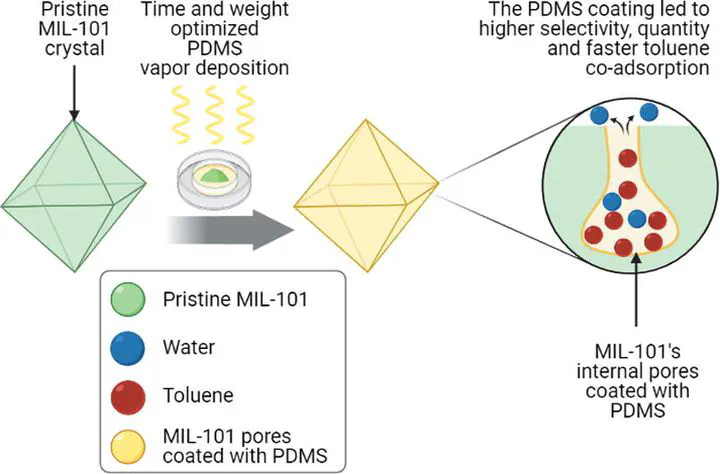Fabrication of MIL-101-polydimethylsiloxane composites for environmental toluene abatement from humid air
Jan 1, 2022·
,
,
 ,
·
0 min read
,
·
0 min read
L. H. Mohd Azmi
P. Cherukupally
E. Hunter-Sellars
Prof. Dr. Bradley P. Ladewig
D. R. Williams

Abstract
Competition for adsorption sites between atmospheric moisture and volatile organic compounds (VOCs) can significantly impact the VOC removal performance of novel metal–organic framework adsorbent such as MIL-101. MIL-101 has high surface area and high porosity, but its inherent hydrophilicity hinders selectivity for hydrophobic organic species in the presence of atmospheric moisture. In this study, a vapor phase deposition of polydimethylsiloxane (PDMS) was used to create more hydrophobic MIL-101 composites. The external hydrophobicity of the composites was evaluated through water contact angle measurements whereas the internal hydrophobicity was assessed using a vapor-sorption based hydrophobicity index. After an optimized vapor deposition time of 0.25 hr employing a low molecular weight PDMS, a MIL-101 composite with enhanced internal hydrophobicity and intact porosity was fabricated. The composite’s efficacy for VOC capture was investigated through toluene-water vapor co-adsorption experiments which involved vapor adsorption at 40% RH and at two toluene concentrations: 0.5% P/P0 and 10% P/P0. At 0.5% toluene P/P0, the new composite exhibited almost 60% higher adsorption capacity and 34% higher overall capture rate relative to pristine MIL-101 due to the presence of a hydrophobic PDMS layer which delayed the onset of water condensation in the mesopores. At 10% toluene P/P0, the new composite’s overall toluene uptake was 2.8 times higher than activated carbon, but slightly lower than pristine MIL-101. This new composite also showed excellent structural stability and adsorption performance after 10 sorption/desorption cycles. The superior performance of the MIL-101-PDMS composite could be utilized to selectively remove toluene from real world humidities and VOC concentrations.
Type
Publication
Chemical Engineering Journal